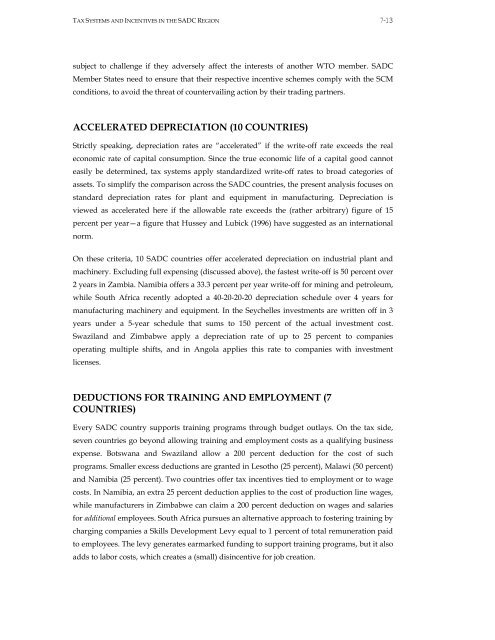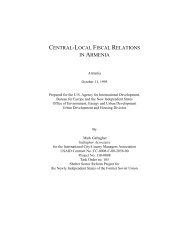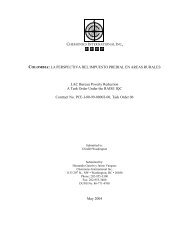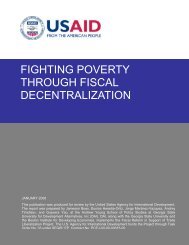Effectiveness and Economic Impact of Tax Incentives in the SADC ...
Effectiveness and Economic Impact of Tax Incentives in the SADC ...
Effectiveness and Economic Impact of Tax Incentives in the SADC ...
You also want an ePaper? Increase the reach of your titles
YUMPU automatically turns print PDFs into web optimized ePapers that Google loves.
TAX SYSTEMS AND INCENTIVES IN THE <strong>SADC</strong> REGION 7-13<br />
subject to challenge if <strong>the</strong>y adversely affect <strong>the</strong> <strong>in</strong>terests <strong>of</strong> ano<strong>the</strong>r WTO member. <strong>SADC</strong><br />
Member States need to ensure that <strong>the</strong>ir respective <strong>in</strong>centive schemes comply with <strong>the</strong> SCM<br />
conditions, to avoid <strong>the</strong> threat <strong>of</strong> countervail<strong>in</strong>g action by <strong>the</strong>ir trad<strong>in</strong>g partners.<br />
ACCELERATED DEPRECIATION (10 COUNTRIES)<br />
Strictly speak<strong>in</strong>g, depreciation rates are “accelerated” if <strong>the</strong> write-<strong>of</strong>f rate exceeds <strong>the</strong> real<br />
economic rate <strong>of</strong> capital consumption. S<strong>in</strong>ce <strong>the</strong> true economic life <strong>of</strong> a capital good cannot<br />
easily be determ<strong>in</strong>ed, tax systems apply st<strong>and</strong>ardized write-<strong>of</strong>f rates to broad categories <strong>of</strong><br />
assets. To simplify <strong>the</strong> comparison across <strong>the</strong> <strong>SADC</strong> countries, <strong>the</strong> present analysis focuses on<br />
st<strong>and</strong>ard depreciation rates for plant <strong>and</strong> equipment <strong>in</strong> manufactur<strong>in</strong>g. Depreciation is<br />
viewed as accelerated here if <strong>the</strong> allowable rate exceeds <strong>the</strong> (ra<strong>the</strong>r arbitrary) figure <strong>of</strong> 15<br />
percent per year—a figure that Hussey <strong>and</strong> Lubick (1996) have suggested as an <strong>in</strong>ternational<br />
norm.<br />
On <strong>the</strong>se criteria, 10 <strong>SADC</strong> countries <strong>of</strong>fer accelerated depreciation on <strong>in</strong>dustrial plant <strong>and</strong><br />
mach<strong>in</strong>ery. Exclud<strong>in</strong>g full expens<strong>in</strong>g (discussed above), <strong>the</strong> fastest write-<strong>of</strong>f is 50 percent over<br />
2 years <strong>in</strong> Zambia. Namibia <strong>of</strong>fers a 33.3 percent per year write-<strong>of</strong>f for m<strong>in</strong><strong>in</strong>g <strong>and</strong> petroleum,<br />
while South Africa recently adopted a 40-20-20-20 depreciation schedule over 4 years for<br />
manufactur<strong>in</strong>g mach<strong>in</strong>ery <strong>and</strong> equipment. In <strong>the</strong> Seychelles <strong>in</strong>vestments are written <strong>of</strong>f <strong>in</strong> 3<br />
years under a 5-year schedule that sums to 150 percent <strong>of</strong> <strong>the</strong> actual <strong>in</strong>vestment cost.<br />
Swazil<strong>and</strong> <strong>and</strong> Zimbabwe apply a depreciation rate <strong>of</strong> up to 25 percent to companies<br />
operat<strong>in</strong>g multiple shifts, <strong>and</strong> <strong>in</strong> Angola applies this rate to companies with <strong>in</strong>vestment<br />
licenses.<br />
DEDUCTIONS FOR TRAINING AND EMPLOYMENT (7<br />
COUNTRIES)<br />
Every <strong>SADC</strong> country supports tra<strong>in</strong><strong>in</strong>g programs through budget outlays. On <strong>the</strong> tax side,<br />
seven countries go beyond allow<strong>in</strong>g tra<strong>in</strong><strong>in</strong>g <strong>and</strong> employment costs as a qualify<strong>in</strong>g bus<strong>in</strong>ess<br />
expense. Botswana <strong>and</strong> Swazil<strong>and</strong> allow a 200 percent deduction for <strong>the</strong> cost <strong>of</strong> such<br />
programs. Smaller excess deductions are granted <strong>in</strong> Lesotho (25 percent), Malawi (50 percent)<br />
<strong>and</strong> Namibia (25 percent). Two countries <strong>of</strong>fer tax <strong>in</strong>centives tied to employment or to wage<br />
costs. In Namibia, an extra 25 percent deduction applies to <strong>the</strong> cost <strong>of</strong> production l<strong>in</strong>e wages,<br />
while manufacturers <strong>in</strong> Zimbabwe can claim a 200 percent deduction on wages <strong>and</strong> salaries<br />
for additional employees. South Africa pursues an alternative approach to foster<strong>in</strong>g tra<strong>in</strong><strong>in</strong>g by<br />
charg<strong>in</strong>g companies a Skills Development Levy equal to 1 percent <strong>of</strong> total remuneration paid<br />
to employees. The levy generates earmarked fund<strong>in</strong>g to support tra<strong>in</strong><strong>in</strong>g programs, but it also<br />
adds to labor costs, which creates a (small) dis<strong>in</strong>centive for job creation.











